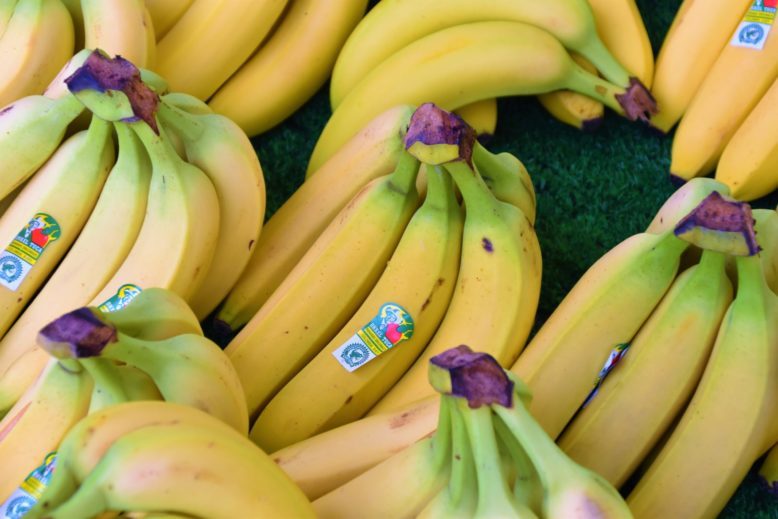
Now that winter is upon us and our local New Jersey bounty is dormant until spring, it’s a great time to look to fruits and vegetables from other areas of the country and the world to bring warmth and comfort. For me, bananas always do the trick!
Growing up poor in North Jersey in the late 1940s and 1950s, my Italian immigrant father got into the business of peddling fruit, including bananas. Back then, bananas came on a stalk with eight or more “hands,” each of which contained anywhere from 10-20 bananas depending on the size of the stalk. You had to go down to the piers in New York City to get the bananas and I can still remember going with Pop and watching the men carrying those big, heavy stalks off the ships.
Pop would buy a lot of stalks and bring them back to our house, where he’d ripen them by hanging them on hooks in our basement. The basement was off limits to me and my younger brother David because, once the cold bananas from the belly of the ship started to warm up, spiders and even snakes that were tucked up in between the hands of bananas would wake up from their dormancy, and mom was afraid that we’d get bitten. Luckily, we never did!
After Pop ripened the bananas, he’d cut them from the stalk, split them into hands of 4-8 bananas, and sell them door to door, an easy job because bananas were and still are so popular.
Eventually, the process changed. Since the 1970s, bananas have been cut from the stalks, boxed right in the Central and South American fields, and shipped here by the box. There are no more stalks involved, but I’m still deathly afraid of snakes!
Considered the most widely consumed fruit on the planet, bananas are high in potassium, magnesium, vitamins C and B6, and pectin, a form of fiber. They’re also high in antioxidants and deliver a wide variety of health benefits, including reducing blood pressure, aiding in digestion and weight loss, relieving heartburn, morning sickness, and anemia, curing hangovers, and even providing relief from mosquito bites (simply rub the inside of the peel on the bite).
BANANA FACTS
The most familiar of the tropical fruits, bananas are in abundant supply at moderate prices all year round. Top exporters of bananas to the U.S. include Central American countries like Costa Rica, Honduras, Ecuador and Panama. But bananas are grown in tropical areas all over the world, including India, which is the leading producer of bananas globally with an estimated 35 million tons in 2022, or over 20 percent of the world’s total banana production.
Bananas grow in clusters, or hands, that usually contain 12-14 bananas. These grow on huge stalks of 7-12 hands on a plant that’s actually an enormous, tree-like herb. Because they ripen best off the tree and are fragile and easily-bruised when ripe, bananas are shipped green and usually arrive at the market with a fair amount of green still showing.
While special varieties of bananas include red-skinned and miniature versions, the main difference you’ll find with them is their higher price, not their flavor or texture. There are actually over 1,000 different banana varieties, with the “Cavendish” variety (named after England’s William Cavendish, the 19th-century Duke of Devonshire) being the most popular.
SELECTION & STORAGE
For the best eating experience, choose firm, unscarred bananas that are greenish to greenish-yellow and ripen them at home. A golden yellow banana is ripe and fragile and the flesh may be bruised even though you can’t see bruises on the skin. Don’t buy bananas if they’re grass green, as they may deteriorate without ever ripening, especially if they’ve been exposed to cold temperatures. And don’t be afraid of bananas with brown specks on the peel, as these are loaded with sugar and taste great. Once fully ripe, bananas deteriorate fairly rapidly, so refrigerate fully ripe bananas if desired, though I don’t recommend it because I feel it hurts their taste and lessens their nutritional value.
PREPARATION
Other than simply peeling and eating bananas raw or slicing them onto cereal, peeled bananas are great pierced with a stick, dipped in chocolate, and frozen. You can also try them sliced and sautéed briefly in butter and brown sugar (and a little rum if you like!) before serving over ice cream. Overripe bananas are perfect for cooking or baking; incorporate them into items like banana bread, cake, muffins, or smoothies, even when their skins are nearly all black.
My wife Bette’s banana bread is an all-time favorite in the Napolitano household. I know you’ll enjoy this tasty comfort food this winter as well!
Bette’s Best Banana Bread
- 3 ripe bananas, mashed
- 1/3 cup butter, melted
- 1 cup sugar (can easily be reduced to ¾ cup)
- 1 egg, beaten
- 1 teaspoon vanilla
- 1 teaspoon baking soda
- Pinch of salt
- 1½ cups all-purpose flour
Preheat oven to 350 degrees. In a large mixing bowl, mix butter into the mashed bananas, then fold in the sugar, egg, and vanilla. Sprinkle the baking soda and salt over the mixture and stir together. Add the flour last and stir until well blended. Pour mixture into a buttered 4×8-inch loaf pan and bake for 50 minutes. Cool on a rack. Remove from pan and slice to serve.
About “Produce Pete” Napolitano
With over 65 years of experience in the produce industry, New Jersey’s own “Produce Pete” Napolitano is a renowned fruit and vegetable expert, author, and TV personality who’s appeared on a highly popular segment on NBC’s Weekend Today in New York, broadcast every Saturday morning for over 28 years. For more information, visit producepete.com.
About Susan Bloom
A regular contributor to New Jersey Monthly and a variety of other well-known local and national publications, Susan Bloom is an award-winning New Jersey-based freelance writer who covers topics ranging from health and lifestyle to business, food and more. She’s collaborated with Produce Pete on a broad range of articles for over a decade.
No one knows New Jersey like we do. Sign up for one of our free newsletters here. Want a print magazine mailed to you? Purchase an issue from our online store.
